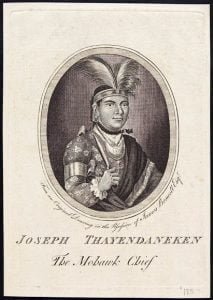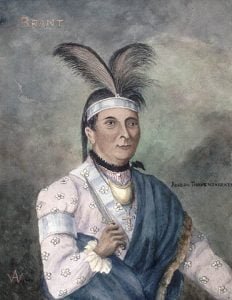
Thayendanegea ‘Two Sticks of Wood Bound Together-denoting strength’ was a Mohawk Pine Tree Chief. He was born in 1742 on the banks of the Ohio River while his parents were on a hunting trip in that section. His home was at Canajoharie Castle in the Mohawk Valley of New York State. Thayendanegea was 13 years old when he went on his first war path. He joined the Mohawk warriors under Aroniateka or Chief Hendrick at the Battle of Lake George in 1755. He later attended Dr. Wheelock’s School at Lebanon, Conn., where he learned to read and write.
- Read a more complete biography of Joseph Brant, Captain of the Six Nations
During the Revolutionary War he and most of his people fought on the side of Britain. They did this because of the ancient chain of friendship between the Six Nations and England. In this war he was given a colonel’s commission. In the treaty between England and the United States the Iroquois were forgotten. They were entirely Left out of all of the councils. It was with great difficulty and effort that Thayendanegea persuaded the British to keep their word and live up to the promises and agreements that they had made with the Six Nations at the beginning of the war. England had agreed that, in case she lost the war, the Iroquois would be given a tract of land to take the place of their lost country in what is now New York State. After much effort on the part of Thayendanegea, the Six Nations were given a tract of land 6 miles wide on each side of the Grand River from its mouth to its source, with the promise that it was to be theirs forever. Thayendanegea and other Six Nation Nationals moved to Grand River. This great leader died Nov. 24, 1807. His entire life was spent in the interests of his people.
One of the distinguishing features of his character was his strong sense of justice, As a warrior he was sagacious and brave. His patience and endurance great and his energy untiring. In all of his dealing with his people and with the whites he was honorable. He was a pattern of integrity. His house was a model of kindness and hospitality. Those who knew him described him as amiable, humorous, witty and possessed of a wonderful personality. He was a leader among leaders. In education and letters he was far in advance of many of the generals against whom he fought. He was, to his dying day, a fighter for the welfare and advancement of his people, the Six Nations. This interest in his people was first in his thoughts to the end. His last words ‘to his nephew Teyoninhokarawen’ were: “Have pity on the poor Indians. If you can get any influence with the great, endeavor to do them all the good you can:’
As the young Mohawks journeyed along the great river their thoughts were of this great Mohawk leader of the past. Near the City of Brantford they visited the grave of this famous chief. Here they also saw a church erected by this great Indian.
Brant’s Monument, Brantford, Ontario, Canada

“Erected by the Brant Memorial Association to Thayendanegea, Captain Joseph Brant born 1749, died 1807, interred at Mohawk Church and to the Six Nations Indians for their long and faithful services on behalf of the British Crown and their strict conversance of treaties-contributed to by the Six Nation Indians, the Chippewas. The Dominion of Canada, the Province of Ontario, the City of Brantford, the Counties of Brant and Bruce, the British Government, etc.”
Retracing their trail back to Buffalo, the warriors headed south following the shore of Lake Erie. At Irving they turned left and visited the Cattaraugus Seneca Reservation. Leaving Cattaraugus they headed south again, passing through a hilly region to the City of Salamanca. They were on the Allegany Seneca Reservation, called by the Iroquois, “Ohio.” Heading southeast through the Reservation the Mohawks were soon at Red House, a section of the Reservation. Near here they visited the grave of a noted Seneca leader of Colonial period. His name was Tenh-wen-nyos and he was known among white folks as Governor Blacksnake. Over his grave was a monument upon which were the following words: Grave Of Tenh-Wen-Nyos
